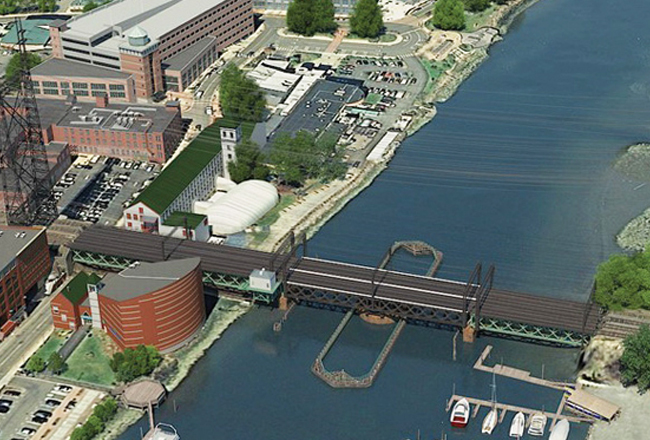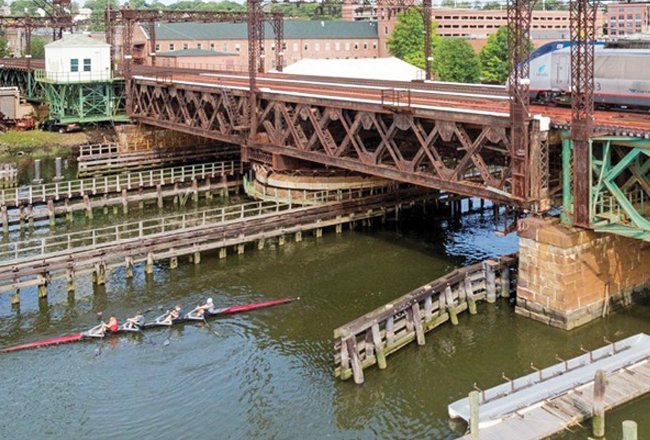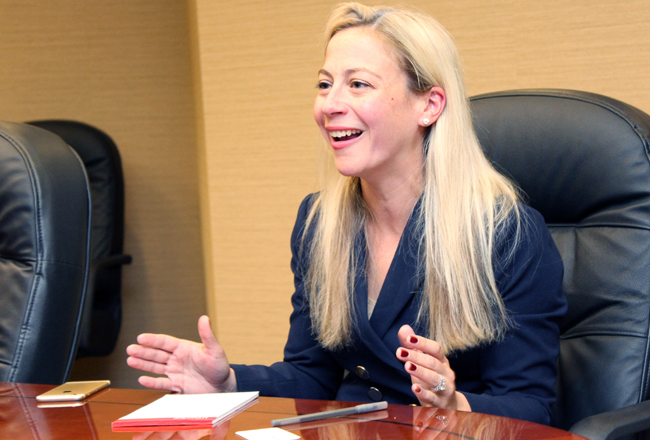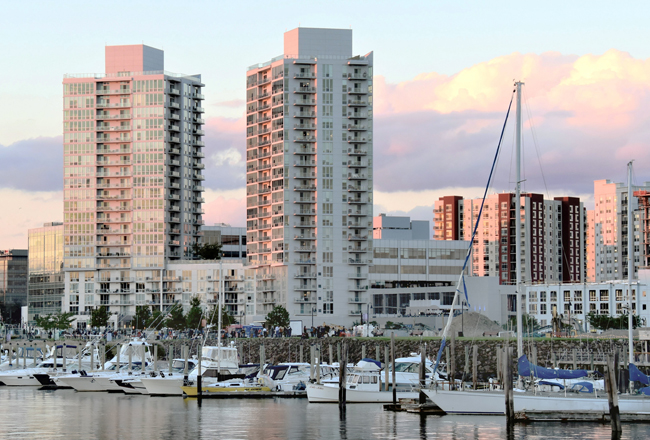After years of discussions, delays, distress ”” and no small amount of discord ”” the replacement of Norwalk”™s 122-year-old Walk Bridge is slowly coming into focus.
The structure carries rail traffic on Metro-North”™s New Haven Line as well as Amtrak service on the Northeast Corridor that serves passengers traveling between Boston, New York and Washington, D.C.
“It”™s been a long process,” allowed Norwalk Mayor Harry Rilling, “and there”™s still quite some time to go.”

The new bridge, which according to Connecticut Department of Transportation Manager of Facilities and Transit James Fallon is 60 percent designed, carries an estimated cost of $511 million ”” part of a total $1.2 billion package that also involves:
Ӣ The replacement of the Fort Point Street Bridge.
Ӣ The replacement of the 100-year-plus-old East Avenue Railroad Bridge, which also will involve a number of roadway improvements and upgrades to the East Norwalk Station.
Ӣ The CP243 Interlocking Project, which will facilitate construction of the new Walk Bridge by allowing trains to switch tracks and maintain service during the two-track outage.
Ӣ The Danbury Branch Dockyard Project, which will electrify about a mile of tracks on the southern portion of Metro-NorthӪs Danbury Branch to increase operational flexibility. As part of the Dockyard Project, the Ann Street Bridge is being expanded from two to three tracks to provide train storage.
“Frankly, it”™s a pretty large and complex project,” Fallon said. “Funding is always an issue with a project like this.”
The need for a new Walk Bridge first became obvious in 2014, when the swing-arm bridge failed to close twice, disrupting travel on the New Haven Line, the nation”™s busiest commuter line. A year later, plans were announced to begin construction on a new bridge in 2016, with a completion date of 2020.
While work on the $242 million CP243 and the $98 million Dockyard Project began in October, construction of the new Walk Bridge is now expected to begin in late 2019, according to Fallon, while Rilling said he didn”™t expect any “significant construction until about 2020.”
Either way, the entire project is expected to take four or five years to complete.
“Going through the cost, the environmental process, evaluating all of the alternative solutions, working through the various state and federal processes ”” it all takes time,” Fallon said.
The additional projects also added to the delay, he noted.
“The three railroad bridges are all of similar vintage (as the Walk Bridge), 120-plus years old,” he said. “We felt that incorporating them all into one project made the most sense. This way we don”™t have to come back five years later to do the work necessary on the others.”
As for the inexact completion time, Fallon said the DOT was sticking with “48 to 54 months” partly as a protection against variables like weather and other delays and partly as a public relations move. “When we talk to the public, we can”™t give them an exact month” when the work will be done, he said. “There are a lot of unknowns and uncertainties involved. But we work to provide as much information, and to make ourselves available and accessible, as we can.”
That was not always the case, according to Rilling. When the Walk Bridge replacement was first being discussed, the DOT “was less than transparent,” he said. “They”™d decide on something and we”™d only find out about it later. We felt the situation could be improved, so we reached out to the governor”™s office to express our concerns ”” and things have improved.”
The improved communications extend to the public, Rilling said, noting the establishment of the Walk Bridge Program Welcome Center at 20 Marshall St., which hosted a pair of public information presentations on Nov. 28 and an “open house” on Dec. 8 that featured a virtual reality tour of the new bridge.

Rilling praised Susan Prosi, the former senior transportation manager of the South Western Regional Planning Agency, who the city hired last year as its consultant and point person for the Walk Bridge replacement.
“She acts as the liaison between the city of Norwalk and the Department of Transportation,” the mayor said. “She”™s also been to almost 160 meetings over the past year with different groups, different constituencies, and brings information back to us about their concerns, which we act to address.”
Not everyone is happy with Prosi”™s performance, however. Her contract with the city was extended by the Norwalk Common Council on Dec. 11, over the objections of Norwalk Harbor Management Commission Vice Chairman John C. Romano, who said she has been unresponsive to concerns expressed both by the Harbor Commission and the Shellfish Commission.
“I”™m sure she”™s serving a purpose, interacting with different departments, but at the end of the day what are the results?” he told the Business Journal. “She”™s been said to be interacting with the Harbor and Shellfish commissions, but I don”™t know what you consider ”˜interactive”™ to be. She comes to meetings with the DOT entourage and just sits ”” she plays the clock and puts a bill in for her time. I don”™t see how that”™s beneficial.”
Romano granted that Prosi”™s contract doesn”™t specify she has to meet with the two commissions but says such meetings are critical. “If the Harbor Commission and the Shellfish Commission are not consulted, talked to or sat down with, how is she going to find out what our concerns are?” he said. “She has no clue about any of that.”
Romano said that the permitting process for some of the work by the Connecticut Department of Energy and Environment Protection (DEEP), which is still pending, is “subject to our findings and pushbacks, so why wouldn”™t you want us to be part of the process? They have to listen to what our recommendations are. We are not just going to lay back and have them roll over us.”
Prosi was not available for comment, but Rilling came to her defense.
“Her role is to hear what”™s happening (with various stakeholders), report back to us and advise us on what we have to do in response,” he said.
“I”™m not sure (Romano) understands her role,” added Rilling”™s chief of staff, Laoise King. “The reason we send her to these meetings is to make sure she brings the appropriate information back. She is not an expert who”™s able to take a position at these different meetings.”
Another flashpoint is a lawsuit filed against the DOT by conservation group Norwalk Harbor Keeper, which maintains that the environment ”” and taxpayers ”” would be better served by a fixed bridge rather than a swing bridge. Noting that the city is not a part of the suit, Rilling said the suit, filed in U.S. District Court, has “had no impact on the progress of the project to this point.”
Fallon at the DOT said a fixed bridge, or simply undertaking repairs to the existing Walk Bridge, were not the answers to the problem.
“With the latest bridge building technology, this is actually less expensive and less time-consuming than building a fixed bridge,” he said.
Trying to repair the bridge would simply be putting off the problem, Fallon said, adding that building a new Walk Bridge will have the fewest environmental impacts, and that impacts to rail service and Norwalk River navigation during construction will be “as minimal as they can be.”






















